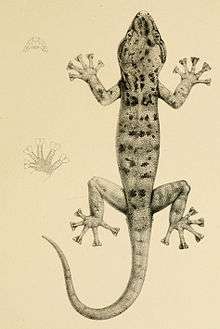Haemodracon
| Haemodracon | |
|---|---|
 | |
| Haemodracon riebeckii | |
| Scientific classification | |
| Kingdom: | Animalia |
| Phylum: | Chordata |
| Subphylum: | Vertebrata |
| Class: | Reptilia |
| Order: | Squamata |
| Suborder: | Sauria |
| Infraorder: | Gekkota |
| Family: | Phyllodactylidae |
| Genus: | Haemodracon Bauer, Good & Branch, 1997 |
Haemodracon is a small genus of rare geckos from Socotra archipelago.
It contains the following species:[1]
- Haemodracon riebeckii (W. Peters, 1882) — type species
- Haemodracon trachyrhinus (Boulenger, 1899)
The genus name is related to Dracaena cinnabari — the most famous tree of Socotra. It gives a red resin known as dragon's blood. The word Haemodracon consist of Ancient Greek: αἷμα (haema) meaning "blood", and dracon meaning "dragon".[1] The specific name, riebeckii, is in honor of German ethnologist Emil Riebeck.[2]
H. riebeckii lives on Socotra Island and nearby Samhah Island. It is bigger, more widespread and more commonly seen. H. trachyrhinus lives only on Socotra Island.[3] Both species are regarded as Least concern by IUCN.[4][5] They are active at night and live mainly in rocky habitats.[3]
References
- 1 2 Bauer A.M.; Good D.A.; Branch W.R. (1997). "The taxonomy of the southern African leaf-toed geckos (Squamata: Gekkonidae), with a review of Old World "Phyllodactylus " and the description of five new genera". Proceedings of the California Academy of Sciences, 4th ser. 49 (14): 447–497. ISSN 0068-547X.
- ↑ Beolens B.; Watkins M.; Grayson M. (2011). The Eponym Dictionary of Reptiles. Baltimore: Johns Hopkins University Press. xiii + 296 pp. ISBN 978-1-4214-0135-5. (Haemodracon riebeckii, p. 221).
- 1 2 Razzetti E.; Sindaco R.; Grieco C.; et al. (2011). "Annotated checklist and distribution of the Socotran Archipelago Herpetofauna (Reptilia)" (PDF). Zootaxa. 2826: 1–44. ISSN 1175-5334.
- ↑ "Haemodracon riebeckii ". IUCN Red List of Threatened Species. Version 2013.2. International Union for Conservation of Nature. 2011. Retrieved 15 May 2014.
- ↑ "Haemodracon trachyrhinus". IUCN Red List of Threatened Species. Version 2013.2. International Union for Conservation of Nature. 2009. Retrieved 15 May 2014.
This article is issued from Wikipedia - version of the 9/22/2016. The text is available under the Creative Commons Attribution/Share Alike but additional terms may apply for the media files.